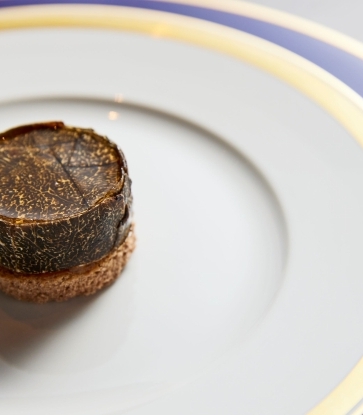Tucked away in a quiet residential corner of Shirokane, Yama (meaning “mountain”) welcomes guests with a minimalist wooden door, leading into an intimate six-seat counter and a private room for four. Inside, antique glassware lines the space, evoking the feel of a sensory laboratory.
For Katsumata, a MICHELIN-Starred dessert restaurant was always the goal. “The MICHELIN Guide evaluates the dining experience—so why should a dessert-only experience be an exception?” he says.
At Yama, there is no à la carte menu—just a single eight-course chef’s choice, highlighting Japan’s seasonal fruits in their purest form. One savory dish is included midway through, yet the real achievement is how Katsumata has created a MICHELIN-worthy experience through desserts alone.

Mastering One Craft with Relentless Dedication
Born in 1985 in Fujiyoshida, Yamanashi—a town known for its textiles—Katsumata grew up in a family of necktie makers spanning four generations. His childhood dream was to become a Chinese chef, inspired by a local restaurant, but with no specialized schools for Chinese cuisine, he pivoted to patisserie, drawn to the idea of mastering a single discipline.
After graduating from pastry school, he trained at the Nagoya Marriott Associa Hotel, renowned for producing champions of the Coupe du Monde de la Pâtisserie (often called the Olympics of confectionery). At just 21, he won a national sugar art competition, later refining his craft as head pastry chef at the MICHELIN-Starred Sola in Paris, where he created daily desserts using the freshest market produce.

Breaking Free from Recipes
Unlike traditional pastry chefs, who rely on precise recipes, Katsumata takes an intuitive approach. “French chefs sometimes dismiss Japanese fruits as ‘just sweet,’” he explains. “But that’s because they’re used to working with unripe tropical fruits that require alcohol to enhance aroma. In Japan, we have access to fruit at its peak—naturally fragrant, with no need for intervention.”
Rather than using commercial fruit purées, which offer consistency but lack nuance, Katsumata works directly with farmers and visits Toyosu Market twice a week, selecting ingredients at their prime. Each dish is fine-tuned in real time, adjusted to the variations in each fruit.
Treating Fruits Like Sushi
Temperature control is key to his philosophy. Much like Edo-style sushi chefs carefully age fish to develop its umami, Katsumata stores certain fruits—such as pears—in a multi-zone aging room to bring out their optimal flavor and texture.“I imagine how it would feel if I were the fruit,” he says. “Rather than being shocked by a drastic temperature change, wouldn’t it be better to stay in a warm, stable environment—like soaking in a hot spring?”
Each fruit, he believes, has a personality. Chestnuts, for example, are “reserved,” requiring gentle coaxing, while citrus fruits are “lively” and shine with acidity. By observing their natural traits, he “listens” to what each ingredient needs, rather than imposing structure upon it.

A New Approach to Dessert Dining
While Yama’s menu is primarily sweet, the inclusion of one savory course keeps the experience dynamic. The fifth dish always offers a surprise—perhaps a quiche, infused with sansho pepper or seasonal herbs like rapeseed blossoms. Katsumata also experiments with contrasts in temperature and texture—deep-frying Japanese mangoes in crispy spring roll wrappers, for example, to heighten their aroma and creaminess.
Thoughtfully paired drinks, inspired by the character of each ingredient, complete the experience, making every course unexpected yet harmonious.

Reaching New Heights
Since opening Yama in 2019, Katsumata has refined his vision, overcoming early challenges—including the disruptions of the pandemic—to establish a concept unlike any other. Like Mount Fuji, which overlooks his hometown, Katsumata sees his journey as an ongoing climb. “In Berlin, CODA Dessert Dining has Two MICHELIN Stars,” he says with a smile. His ambition? To take Yama even higher.
For now, he’s content knowing he’s changed the game for pastry chefs in Japan—one thoughtfully crafted dessert at a time.














%20-%20Aman%20Nai%20Lert.jpg)
.jpg)



